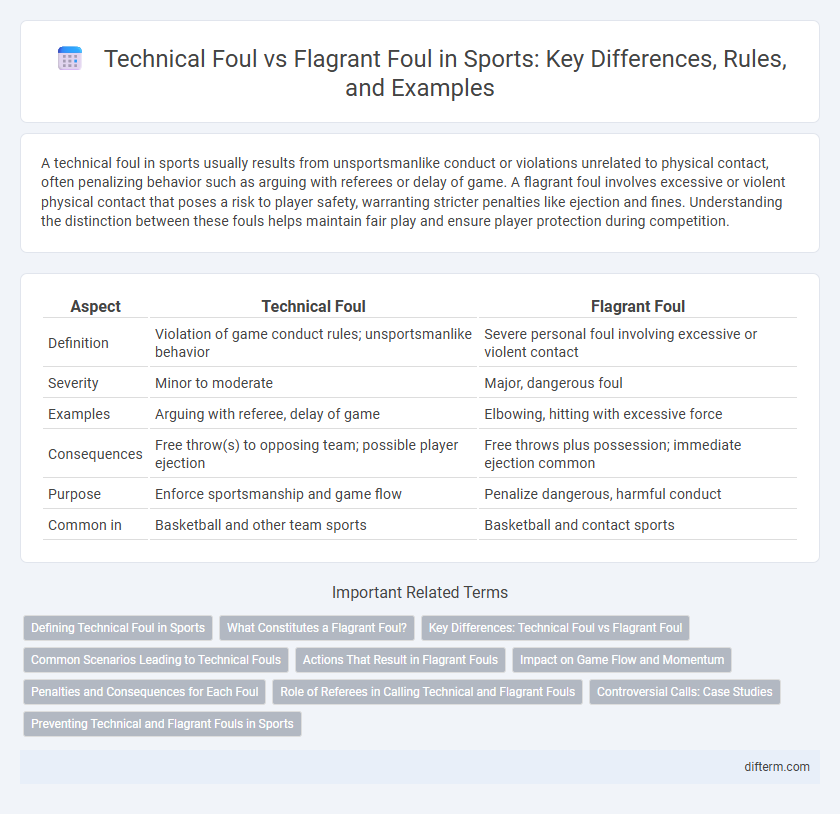A technical foul in sports usually results from unsportsmanlike conduct or violations unrelated to physical contact, often penalizing behavior such as arguing with referees or delay of game. A flagrant foul involves excessive or violent physical contact that poses a risk to player safety, warranting stricter penalties like ejection and fines. Understanding the distinction between these fouls helps maintain fair play and ensure player protection during competition.
Table of Comparison
| Aspect | Technical Foul | Flagrant Foul |
|---|---|---|
| Definition | Violation of game conduct rules; unsportsmanlike behavior | Severe personal foul involving excessive or violent contact |
| Severity | Minor to moderate | Major, dangerous foul |
| Examples | Arguing with referee, delay of game | Elbowing, hitting with excessive force |
| Consequences | Free throw(s) to opposing team; possible player ejection | Free throws plus possession; immediate ejection common |
| Purpose | Enforce sportsmanship and game flow | Penalize dangerous, harmful conduct |
| Common in | Basketball and other team sports | Basketball and contact sports |
Defining Technical Foul in Sports
A technical foul in sports is a penalty called for unsportsmanlike conduct or violations that do not involve physical contact with an opponent, such as arguing with officials, delay of game, or illegal substitutions. This foul results in free throws or possession awarded to the opposing team but typically carries less severe consequences than a flagrant foul. Understanding the distinction between technical and flagrant fouls is crucial for players and coaches to maintain fair play and avoid escalating penalties during games.
What Constitutes a Flagrant Foul?
A flagrant foul in sports, particularly basketball, involves excessive or violent contact that poses a significant risk of injury to an opponent, distinguishing it from a technical foul which typically relates to non-contact infractions or unsportsmanlike conduct. The NBA defines a flagrant foul as unnecessary and/or excessive contact committed by a player against an opponent, often resulting in immediate free throws and possible ejection. Understanding the severity and intent behind the action is crucial for referees to differentiate flagrant fouls from less severe technical fouls, ensuring player safety and game integrity.
Key Differences: Technical Foul vs Flagrant Foul
Technical fouls are penalties for non-contact infractions like unsportsmanlike conduct or delay of game, resulting in free throws and possession changes. Flagrant fouls involve excessive or violent physical contact deemed dangerous, often leading to immediate player ejection and stricter disciplinary action. The key difference lies in the nature of the foul, with technical fouls penalizing behavior and flagrant fouls addressing severe physical aggression.
Common Scenarios Leading to Technical Fouls
Common scenarios leading to technical fouls include unsportsmanlike conduct such as arguing with referees, acting disrespectfully toward opponents, and delay of game violations. Technical fouls often result from illegal coach or player behavior without physical contact, like excessive timeouts or hanging on the rim. These fouls differ from flagrant fouls, which involve violent or intentional physical contact that risks injury.
Actions That Result in Flagrant Fouls
Actions resulting in flagrant fouls typically involve excessive or violent contact that poses a risk of injury to an opponent. Examples include intentional punching, hitting, or aggressively shoving a player, as well as unnecessary force used during a play. Unlike technical fouls, flagrant fouls are penalized more severely due to their dangerous nature and direct impact on player safety.
Impact on Game Flow and Momentum
Technical fouls disrupt the game's rhythm by stopping play for explanations or penalties, often breaking team momentum without causing immediate player removal. Flagrant fouls have a more significant impact as they can lead to player ejections, shifting team dynamics and intensifying emotional responses. The severity of flagrant fouls usually results in a game flow shift, altering offensive and defensive strategies and potentially changing the game's outcome.
Penalties and Consequences for Each Foul
Technical fouls result in one or two free throws for the opposing team and possession of the ball, emphasizing punishment for unsportsmanlike conduct or violations by players or coaches. Flagrant fouls involve excessive or violent contact, leading to two free throws, possession for the offended team, and potential ejection of the offending player. The severity of penalties for flagrant fouls reflects the aim to deter dangerous behavior and maintain player safety in basketball.
Role of Referees in Calling Technical and Flagrant Fouls
Referees play a crucial role in maintaining game integrity by accurately identifying and calling technical and flagrant fouls based on the severity of player actions and unsportsmanlike conduct. Technical fouls typically address non-contact infractions such as disrespect or delay of game, while flagrant fouls involve excessive or violent contact posing safety risks to players. The referees' judgment directly impacts game flow, player discipline, and enforcement of league rules to ensure fair play and player safety.
Controversial Calls: Case Studies
Technical fouls and flagrant fouls often ignite heated debates in sports due to their subjective nature and significant impact on game outcomes. Notable case studies, such as the 2019 NBA playoffs, highlight controversial calls where ambiguous referee decisions altered momentum and playoff trajectories. These incidents underscore the need for clearer guidelines and technological assistance to minimize bias and ensure fair enforcement of rules.
Preventing Technical and Flagrant Fouls in Sports
Preventing technical and flagrant fouls in sports requires a combination of strict rule enforcement, player education, and effective coaching strategies that emphasize sportsmanship and discipline. Regular training sessions focusing on emotional control, proper conduct, and awareness of game rules significantly reduce instances of unsportsmanlike behavior leading to such fouls. Implementing real-time monitoring by referees and using video replay technology also helps in promptly identifying and addressing potential infractions, maintaining fair play and athlete safety.
Technical foul vs flagrant foul Infographic

 difterm.com
difterm.com